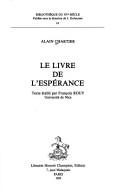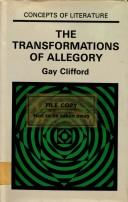| Listing 1 - 10 of 46 | << page >> |
Sort by
|
Book
ISBN: 0814270476 0814211828 081425649X Year: 2012 Publisher: Columbus : Ohio State University Press,
Abstract | Keywords | Export | Availability | Bookmark
 Loading...
Loading...Choose an application
- Reference Manager
- EndNote
- RefWorks (Direct export to RefWorks)
Allegory. --- Personification in literature --- Symbolism in literature
Book
ISBN: 9781788730259 1788730259 9781788730433 Year: 2019 Publisher: London ; New York : Verso,
Abstract | Keywords | Export | Availability | Bookmark
 Loading...
Loading...Choose an application
- Reference Manager
- EndNote
- RefWorks (Direct export to RefWorks)
This major new work by Fredric Jameson is not a book about 'method,' but it does propose a dialectic capable of holding together in one breath the heterogeneities that reflect our biological individualities, our submersion in collective history and class struggle, and our alienation to a disembodied new world of information and abstraction. Eschewing the arid secularities of philosophy, Walter Benjamin once recommended the alternative of the rich figurality of an older theology; in that spirit we here return to the antiquated Ptolemaic systems of ancient allegory and its multiple levels (a proposal first sketched out in The Political Unconscious); it is tested against the epic complexities of the overtly allegorical works of Dante, Spenser and the Goethe of Faust II, as well as symphonic form in music, and the structure of the novel, postmodern as well as Third World: about which a notorious essay on National Allegory is here reprinted with a theoretical commentary; and an allegorical history of emotion is meanwhile rehearsed from its contemporary, geopolitical context.
Allegory. --- Ideology in literature. --- Allegory --- Ideology in literature --- Personification in literature --- Symbolism in literature --- Literary semiotics
Book
ISBN: 022677662X Year: 2021 Publisher: Chicago : The University of Chicago Press,
Abstract | Keywords | Export | Availability | Bookmark
 Loading...
Loading...Choose an application
- Reference Manager
- EndNote
- RefWorks (Direct export to RefWorks)
Katharine Breen proposes that medieval personifications should be understood neither as failed novelistic characters nor as instruments of heavy-handed didacticism. She argues that personifications are instead powerful tools for thought that help us to remember and manipulate complex ideas, testing them against existing moral and political paradigms. Specifically, different types of medieval personification should be seen as corresponding to positions in the rich and nuanced medieval debate over universals. Breen identifies three different types of personification - Platonic, Aristotelian, and Prudentian - that gave medieval writers a surprisingly varied spectrum with which to paint their characters.
Literature, Medieval --- Personification in literature. --- Allegory. --- Literature --- History and criticism. --- Philosophy.
Book
ISBN: 0713157704 Year: 1975 Publisher: London : Edward Arnold,
Abstract | Keywords | Export | Availability | Bookmark
 Loading...
Loading...Choose an application
- Reference Manager
- EndNote
- RefWorks (Direct export to RefWorks)
Allegory --- Christian poetry, English (Middle) --- -Personification in literature --- Symbolism in literature --- History and criticism --- Langland, William --- -Technique --- -History and criticism --- Allegory. --- History and criticism. --- Langland, William, --- Technique. --- Personification in literature --- Langland, Robert, --- Langland, Uĭli︠a︡m,

ISBN: 2852030926 9782852030923 Year: 1989 Volume: 51 Publisher: Paris : Editions Honoré Champion,
Abstract | Keywords | Export | Availability | Bookmark
 Loading...
Loading...Choose an application
- Reference Manager
- EndNote
- RefWorks (Direct export to RefWorks)
Old French literature --- Dialogues, French. --- Allegory. --- Dialogues, French --- Allegory --- Personification in literature --- Symbolism in literature --- French dialogues --- French literature
Book
ISBN: 0814271502 081421102X 0814256791 Year: 2009 Publisher: Columbus : Ohio State University Press,
Abstract | Keywords | Export | Availability | Bookmark
 Loading...
Loading...Choose an application
- Reference Manager
- EndNote
- RefWorks (Direct export to RefWorks)
English literature --- Body and soul in literature. --- Allegory. --- History and criticism. --- Personification in literature --- Symbolism in literature

ISBN: 0710079761 071007977X 9780710079763 9780710079770 Year: 1974 Publisher: London Boston : Routledge & K. Paul,
Abstract | Keywords | Export | Availability | Bookmark
 Loading...
Loading...Choose an application
- Reference Manager
- EndNote
- RefWorks (Direct export to RefWorks)
Literary rhetorics --- Allegory --- Allégorie --- Allegory. --- 82-31 --- Personification in literature --- Symbolism in literature --- Roman --- 82-31 Roman --- Allégorie --- Allégorie (littérature) --- Allégorie (littérature)
Book
ISBN: 0691063060 132288367X 0691617139 0691644284 1400870240 0691100438 9781400870240 9780691617138 Year: 2015 Publisher: Princeton, NJ
Abstract | Keywords | Export | Availability | Bookmark
 Loading...
Loading...Choose an application
- Reference Manager
- EndNote
- RefWorks (Direct export to RefWorks)
Isabel MacCaffrey contends that, in allegory, the mind makes a model of itself, and she shows that The Faerie Queene, mirroring as it does the mind's structure, is both a treatise on and an example of the central role that imagination plays in human life.Viewing the poem as a model of Spenser's universe, the author investigates the poet's theory of knowledge and the role of imagination in the construction of cosmic models. She begins with a survey of theories of the imagination and the creation of fictions, establishing a context in which allegorical images may be understood throughout the European allegorical tradition to which The Faerie Queene belongs. Isabel MacCaffrey's new readings show that insofar as Spenser's poem concerns modes of knowledge, it offers the reader an anatomy of its own composition, an analysis of imagination in its varied relations to the world.Originally published in 1976.The Princeton Legacy Library uses the latest print-on-demand technology to again make available previously out-of-print books from the distinguished backlist of Princeton University Press. These editions preserve the original texts of these important books while presenting them in durable paperback and hardcover editions. The goal of the Princeton Legacy Library is to vastly increase access to the rich scholarly heritage found in the thousands of books published by Princeton University Press since its founding in 1905.
Immerito, --- Spencer, Edmund, --- Spenser, Edmond, --- Allegory. --- Spenser, Edmund, --- Epic poetry, English --- Personification in literature --- Symbolism in literature --- History and criticism. --- Technique. --- Spenser, Edmund
Book
ISBN: 0691644543 1400870720 9781400870721 9780691617404 9780691046167 0691617406 0691046166 9780691046167 Year: 2015 Publisher: Princeton, NJ
Abstract | Keywords | Export | Availability | Bookmark
 Loading...
Loading...Choose an application
- Reference Manager
- EndNote
- RefWorks (Direct export to RefWorks)
Surprisingly little has been written in Western languages about the eighteenth- century Chinese novel Dream of the Red Chamber, perhaps the supreme masterpiece of its entire tradition. In this study, Andrew H. Plaks has used the conceptual tools of comparative literature to focus on the novel's allegorical elements and narrative structure. He thereby succeeds in accounting for the work's greatness in terms that do justice to its own narrative tradition and as well to recent advances in general literary theory.A close textual reading of the novel leads to discussion of a wide range of topics: ancient Chinese mythology, Chinese garden aesthetics, and the logic of alternation and recurrence. The detailed study of European allegorical texts clarifies the directions taken by comparable works of Chinese literature, and the critical tool of the literary archetype helps to locate the novel within the Chinese narrative tradition from ancient mythology to the more recent "novel" form. Professor Plaks' innovative use of traditional criticism suggests the levels of meaning the eighteenth-century author might have expected to convey to his immediate audience.This book provides not only an illuminating analysis of this important novel, but also a significant demonstration that critical concepts derived primarily from Western literary models may be fruitfully applied to Chinese narrative works.Originally published in 1976.The Princeton Legacy Library uses the latest print-on-demand technology to again make available previously out-of-print books from the distinguished backlist of Princeton University Press. These editions preserve the original texts of these important books while presenting them in durable paperback and hardcover editions. The goal of the Princeton Legacy Library is to vastly increase access to the rich scholarly heritage found in the thousands of books published by Princeton University Press since its founding in 1905.
Allegory --- East Asian Languages & Literatures --- Languages & Literatures --- Personification in literature --- Symbolism in literature --- Amérique --- Grande-Bretagne --- Population --- Histoire. --- Colonies --- Allegory. --- Cao, Xueqin, --- America --- History --- Great Britain --- Colonies britanniques
Book
ISBN: 0231538634 9780231538633 9780231164306 0231164300 Year: 2015 Publisher: New York, NY
Abstract | Keywords | Export | Availability | Bookmark
 Loading...
Loading...Choose an application
- Reference Manager
- EndNote
- RefWorks (Direct export to RefWorks)
The shape, lineation, and prosody of postmodern poems are extravagantly inventive, imbuing both form and content with meaning. Through a survey of American poetry and poetics from the end of World War II to the present, Michael Golston traces the proliferation of these experiments to a growing fascination with allegory in philosophy, linguistics, critical theory, and aesthetics, introducing new strategies for reading American poetry while embedding its formal innovations within the history of intellectual thought.Beginning with Walter Benjamin's explicit understanding of Surrealism as an allegorical art, Golston defines a distinct engagement with allegory among philosophers, theorists, and critics from 1950 to today. Reading Fredric Jameson, Angus Fletcher, Roland Barthes, and Craig Owens, and working with the semiotics of Charles Sanders Pierce, Golston develops a theory of allegory he then applies to the poems of Louis Zukofsky and Lorine Niedecker, who, he argues, wrote in response to the Surrealists; the poems of John Ashbery and Clark Coolidge, who incorporated formal aspects of filmmaking and photography into their work; the groundbreaking configurations of P. Inman, Lyn Hejinian, Myung Mi Kim, and the Language poets; Susan Howe's "Pierce-Arrow," which he submits to semiotic analysis; and the innovations of Craig Dworkin and the conceptualists. Revitalizing what many consider to be a staid rhetorical trope, Golston positions allegory as a creative catalyst behind American poetry's postwar avant-garde achievements.
American poetry --- Allegory. --- Surrealism (Literature) --- Poetics. --- Poetry --- Surrealism in literature --- Literature --- Personification in literature --- Symbolism in literature --- History and criticism. --- Technique
| Listing 1 - 10 of 46 | << page >> |
Sort by
|

 Search
Search Feedback
Feedback About UniCat
About UniCat  Help
Help News
News